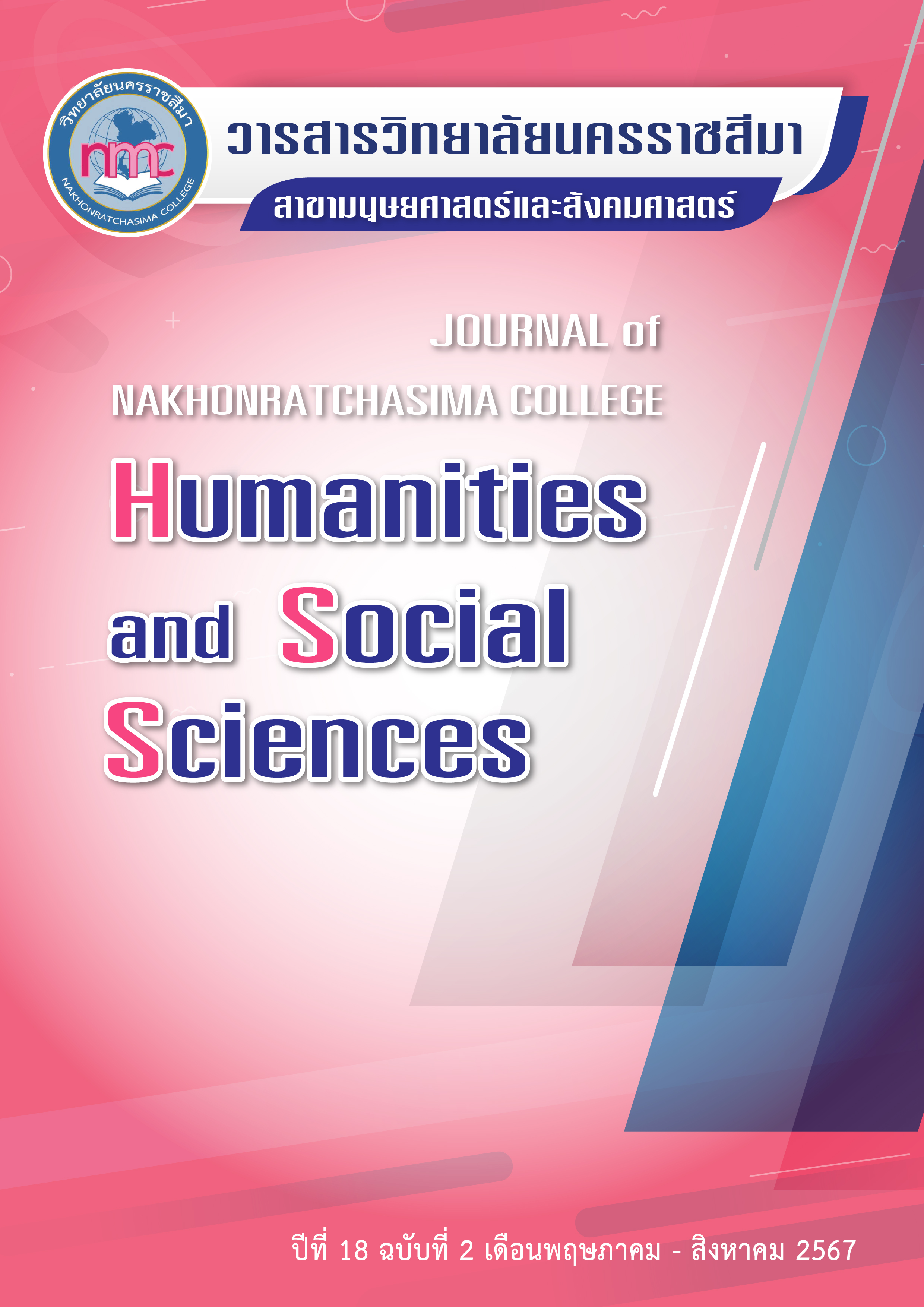อิทธิพลของแนวคิดเกมมิฟิเคชั่นต่อความตั้งใจซื้อสินค้าผ่านแพลตฟอร์มร้านค้าออนไลน์ของผู้บริโภคในเขตกรุงเทพมหานคร
คำสำคัญ:
แนวคิดเกมมิฟิเคชั่น, การได้รับรางวัล, การแข่งขันบทคัดย่อ
การวิจัยในครั้งนี้มีวัตถุประสงค์เพื่อ 1) เพื่อศึกษาอิทธิพลของแนวคิดเกมมิฟิเคชั่น ด้านการได้รับรางวัล ด้านการแข่งขัน ที่ส่งผลต่อความเพลินเพลิดในการซื้อสินค้าออนไลน์ 2) เพื่อศึกษาอิทธิพลของความเพลินเพลิดในการซื้อสินค้าออนไลน์ที่ส่งผลต่อความผูกพันของลูกค้าและการตั้งใจซื้อสินค้าออนไลน์ 3) เพื่อศึกษาอิทธิพลของความผูกพันของลูกค้าที่ส่งผลต่อการตั้งใจซื้อสินค้าออนไลน์ วิเคราะห์ข้อมูลโดยใช้ระเบียบวิธีวิจัยเชิงปริมาณ กลุ่มตัวอย่างคือ ผู้บริโภคที่ใช้แพลตฟอร์มร้านค้าออนไลน์ที่อยู่ในเขตกรุงเทพมหานคร จำนวน 400 คน วิธีการสุ่มตัวอย่างแบบเจาะจง (Purposive sampling) ร่วมกับวิธีการสุ่มตัวอย่างแบบลูกโซ่ (Snowball Sampling) เครื่องมือที่ใช้ในการวิจัย คือแบบสอบถาม วิเคราะห์ข้อมูลโดยใช้โปรแกรมสำเร็จรูปทางสถิติ สถิติที่ใช้ในการวิเคราะห์ข้อมูล ได้แก่ ร้อยละ การแจกแจงความถี่ ค่าเฉลี่ย ส่วนเบี่ยงเบนมาตรฐาน ค่าสัมประสิทธิ์สหสัมพันธ์เพียร์สัน และการวิเคราะห์การถดถอย
ผลการศึกษาพบว่า 1) แนวคิดเกมมิฟิเคชั่นในด้านการได้รับรางวัลมีอิทธิพลเชิงบวกต่อความเพลินเพลิดในการซื้อสินค้าออนไลน์อย่างมีนัยสำคัญทางสถิติ ในขณะที่แต่ด้านการแข่งขันนั้นมีอิทธิพลเชิงบวกต่อความเพลินเพลิดในการซื้อสินค้าออนไลน์อย่างแต่ไม่มีนัยสำคัญทางสถิติ 2) ความเพลินเพลิดในการซื้อสินค้าออนไลน์มีอิทธิพลเชิงบวกต่อความผูกพันของลูกค้าและการตั้งใจซื้อสินค้าออนไลน์ อย่างมีนัยสำคัญทางสถิติ 3) ความผูกพันของลูกค้ายังมีอิทธิพลเชิงบวกต่อการตั้งใจซื้อสินค้าออนไลน์ อย่างมีนัยสำคัญทางสถิติ
เอกสารอ้างอิง
การะเกด สิงห์ทอง. (2564). การพัฒนานวัตกรรมเกมมิฟิเคชั่นเพื่อเรียนรู้การลงทุนกองทุนรวม จุฬาลงกรณ์มหาวิทยาลัย.
จุฑารัตน์ เกียรติรัศมี. (2558). ปัจจัยที่มีผลต่อการซื้อสินค้าผ่านทางแอพพลิเคชั่นออนไลน์ของผู้บริโภคในเขตกรุงเทพมหานครและปริมณฑล. มหาวิทยาลัยธรรมศาสตร์.
ฑิตาพร รุ่งสถาพร. (2563). พฤติกรรมผู้บริโภคต่อการซื้อสินค้าบนช่องทางออนไลน์ในภาวะวิกฤตโควิด-19 ในเขต กรุงเทพมหานครปริมณฑลและพิษณุโลก มหาวิทยาลัยกรุงเทพ.
ทวีพร พนานิรามัย. (2557). ปัจจัยที่มีอิทธิพลเชิงบวกต่อความตั้งใจซื้อสินค้าซุปเปอร์มาร์เก็ตออนไลน์ ของผู้บริโภคในเขตยานนาวา จังหวัดกรุงเทพมหานคร มหาวิทยาลัยกรุงเทพ.
พวงรัตน์ ทวีรัตน์. (2540). วิธีการวิจัยทางพฤติกรรมศาสตร์และสังคมศาสตร์ (7 ed.). มหาวิทยาลัยศรีนครินทรวิโรฒ ประสานมิตร.
วรรณกานต์ โปรณานันท์. (2562). ความผูกพันของผู้บริโภคที่ส่งผลต่อการรับรู้ถึงความเป็นส่วนตัวและความตั้งใจซื้อสินค้าออนไลน์ผ่านสังคมอิเล็กทรอนิกส์ กรณีศึกษา Shopee มหาวิทยาลัยมหิดล.
วสิษฐ์ พรหมบุตร. (2562). ลักษณะของผู้ซื้อ – ลักษณะเว็บไซต์ที่มีต่อการซื้อสินค้าทางอินเตอร์เน็ตในตลาดเกิดใหม่ : การทบทวนวรรณกรรมและกรอบแนวคิดการวิจัย. วารสารวิชาการสถาบันวิทยาการจัดการแห่งแปซิฟิค, 5(2), 314-327.
สำนักงานพัฒนาธุรกรรมทางอิเล็กทรอนิกส์. (2564). e-Commerce ไทย ยุคหลัง COVID-19. . Retrieved 12 กุมภาพันธ์ from https://www.etda.or.th/th/Useful-Resource/Knowledge-Sharing/Perspective-on-Future-of-e-Commerce.aspx
อำพล นววงศ์เสถียร. (2557). พฤติกรรมการตัดสินใจของผู้บริโภคในร้านค้าออนไลน์ในกรุงเทพมหานคร. Panyapiwat Journal, 5(2), 134–149.
A. Niedermeier, L. D. A., Benedikt Jahn. (2018). “Happy Together”: Effects of Brand Community Engagement on Customer Happines. Journal of Relationship Marketing, 18(1), 54-76.
Bauer, J., Linzmajer, M., Nagengast, L., Rudolph, T., & D'Cruz, E. (2020). Gamifying the digital shopping experience: games without monetary participation incentives increase customer satisfaction and loyalty. Journal of Service Management , 31, 563-595.
Bergkvist, L., Tobias, L.,. (2017). Benefits and continued use: A study on gamification, quantified-self and social. Construct measurement in advertising research, 46(1), 129-140.
Bunchball. (2010). Gamification 101: An Introduction to the Use of Game Dynamics to Influence Behavior. Retrieved 3 กันยายน 2565
Chen, X.-P., Hui, C., and Sego, D. J. (1998). The role of organizational citizenship behavior in turnover: conceptualization and preliminary tests of key hypotheses. Journal of Applied Psychology, 83(922).
Cochran, W. G. (1953). Sampling techniques. John Wiley.
Fishbein, M. a. A. (1975). Belief, Attitude, Intention and Behavior: An Introduction to Theory and Research. Addison-Wesley.
Higgins, E. T. (2006). Value from hedonic experience and engagement. . Psychological Review 113, 439–460.
Hong, H., Cao, M., Wang, G.A.,. (2017). The effects of network externalities and herding on user satisfaction with mobile social apps. Journal Electronic Commerce Research, 18(1), 18-31.
Huang, T., Bao, Z., and Li, Y. (2017). Why do players purchase in mobile social network games? An examination of customer engagement and of uses and gratifications theory. Program, 51, 259-277. https://doi.org/10.1108/prog-12-2016-0078
Kankanhalli, A., Tan, B. C., and Wei, K.-K. (2005). Contributing knowledge to electronic knowledge repositories: an empirical investigation. Management Information Systems Quarterly, 29, 113-143.
Kapp, K. M. (2012). The Gamification of Learning and Instruction. Game-Based Methods and Strategies for Training and Education. Pfeiffer.
Kim, H., Suh, K.-S., and Lee, U.-K. (2013). Effects of collaborative online shopping on shopping experience through social and relational perspectives. Information and Management, 50, 169-180.
Lee, C.-L., and Yang, H.-J. (2011). Organization structure, competition and performance measurement systems and their joint effects on performance. Management Accounting Researc, 22, 84-104.
Ma, M., and Agarwal, R. (2007). Through a glass darkly: information technology design, identity verification, and knowledge contribution in online communities. Information Systems Research, 18, 42-67.
Michelle L. Childs, e. a. (2020). Non-traditional marketplaces in the retail apocalypse: investigating consumers' buying behaviours. Journal of Retail & Distribution Management, 48(3).
O’Brien, H. L. (2010). The influence of hedonic and utilitarian motivations on user engagement: the case of online shopping experiences. Interacting with Computers, 22, 344-352.
Przybylski, A. K., Rigby, C. S., and Ryan, R. M. (2010). A motivational model of video game engagement. Review of General Psychology, 14, 154-166.
Qin, H., Peak, D.A., Prybutok, V., . (2021). A virtual market in your pocket: How does mobile augmented reality (MAR) influence consumer decision making? . Journal of Retailing and Consumer Services, 58, 102337.
Sen, R., Subramaniam, C., and Nelson, M. L. . (2008). Determinants of the choice of open source software license. The Interact solution for managing your information system, 25, 207-240.
Sepandar Sepehr and Milena Head. (2013). Competition as an element of gamification for learning: an exploratory longitudinal investigation. In Proceedings of the First International Conference on Gameful Design, Research, and Applications (Gamification '13). Association for Computing Machinery, New York, NY, USA, 2–9. https://doi.org/10.1145/2583008.2583009
SHIPPOP. (2566). SHIPPOP เผยภาพรวมการจัดส่งสินค้า ประจำปี 2565. Retrieved 14 กุมภาพันธ์ 2566 from https://blog.shippop.com/insight-2022/
Sykes, T. A., Venkatesh, V., and Gosain, S. (2009). Model of acceptance with peer support: a social network perspective to understand employees’ system use. Management Information Systems Quarterly, 33, 371-393.
Wakefield, R. L., Wakefield, K. L., Baker, J., and Wang, L. C., . (2011). How website socialness leads to website use. European Journal of Information Systems, 20, 118-132.
Yan Xu et al. (2020). Enhancing Consumer Online Purchase Intention Through Gamification in China: Perspective of Cognitive Evaluation Theory. Frontiers in Psychology, 11.
ดาวน์โหลด
เผยแพร่แล้ว
รูปแบบการอ้างอิง
ฉบับ
ประเภทบทความ
สัญญาอนุญาต
จรรยาบรรณผู้เขียนบทความ
ผู้เขียนบทความต้องรับรองว่าบทความนี้ไม่เคยตีพิมพ์ในวารสารใดหรือสิ่งพิมพ์อื่นๆ มาก่อน ต้องไม่คัดลอกผลงานผู้อื่นมาปรับแต่งเป็นบทความของตน และไม่ได้อยู่ระหว่างการเสนอเพื่อพิจารณาตีพิมพ์ อีกทั้งยอมรับหลักเกณฑ์การพิจารณาและการตรวจแก้ไขบทความต้นฉบับโดยกองบรรณาธิการวารสารวิทยาลัยนครราชสีมา สาขามนุษยศาสตร์และสังคมศาสตร์
บทความทุกเรื่องได้รับการตรวจพิจารณาทางวิชาการโดยผู้ทรงคุณวุฒิที่มีประสบการณ์และมีความเชี่ยวชาญตรงตามสาขาของบทความ ซึ่งผู้เขียนต้องแก้ไขตามคำแนะนำของผู้ทรงคุณวุฒิภายในระยะเวลาที่กำหนด หากไม่เป็นไปตามกำหนดกองบรรณาธิการขอสงวนสิทธิ์และยกเลิกการตีพิมพ์โดยจะแจ้งให้ทราบต่อไป
ข้อความที่ปรากฏในบทความของวารสารนี้เป็นความคิดเห็นของผู้เขียนซึ่งไม่เกี่ยวข้องกับวิทยาลัยนครราชสีมาแต่อย่างใด และกองบรรณาธิการขอสงวนสิทธิ์ในการพิจารณาและตรวจประเมินบทความเพื่อตีพิมพ์ในวารสารของวิทยาลัยนครราชสีมา สาขามนุษยศาสตร์และสังคมศาสตร์



